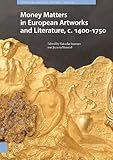Money Matters in European Artworks and Literature, c. 1400-1750 / ed. by Natasha Seaman, Joanna Woodall.
Material type: TextSeries: Visual and Material Culture, 1300 –1700Publisher: Amsterdam : Amsterdam University Press, [2022]Copyright date: ©2022Description: 1 online resource (326 p.)Content type:
TextSeries: Visual and Material Culture, 1300 –1700Publisher: Amsterdam : Amsterdam University Press, [2022]Copyright date: ©2022Description: 1 online resource (326 p.)Content type: - 9789048555789
- Coins in art
- Coins in literature
- Coins, European -- History
- Money in art
- Money in literature
- Money -- History -- Europe
- Art and Material Culture
- Cultural Studies
- Early Modern Studies
- European history
- History of art
- History, Art History, and Archaeology
- Material culture
- c 1500 onwards to present day
- ART / History / Renaissance
- Coins, art, literature, money, mints
- 332.494 23//eng/20220523eng
- online - DeGruyter
| Item type | Current library | Call number | URL | Status | Notes | Barcode | |
|---|---|---|---|---|---|---|---|
 eBook
eBook
|
Biblioteca "Angelicum" Pont. Univ. S.Tommaso d'Aquino Nuvola online | online - DeGruyter (Browse shelf(Opens below)) | Online access | Not for loan (Accesso limitato) | Accesso per gli utenti autorizzati / Access for authorized users | (dgr)9789048555789 |
Frontmatter -- Table of Contents -- List of Illustrations -- Acknowledgments -- Introduction: Embodying Value -- Power and Authority in the Mint -- 1. Weighing Things Up in Maarten de Vos’s Tribunal of the Brabant Mint 1594 -- 2. Scaling the World: Allegory of Coinage and Monetary Governance in the Dutch Republic -- Currency and the Anxieties of Global Trade -- 3. Market Stall in Batavia: Money, Value, and Uncertainty in the Age of Global Trade -- 4. Beyond the Mint: Picturing Gold on the Rijksmuseum’s Box of the Dutch West India Company -- Coins and Persons -- 5. The Heft of Truth: Inwardness and Debased Coinage in Shakespeare’s Plays -- 6. Identity, Agency, Motion: Taylor’s Twelvepence and the Poetry of Commodity -- Coins in and out of Circulation -- 7. Margarethe Butzbach and the Florin Extorted by Blows. Coins Securing Social Bonds in Fifteenth-Century Germany -- 8. Centring the Coin in Jacob Backer’s Woman with a Coin -- Credit and Risk -- 9. Accounting Faith and Seeing ‘Ghost Money’ in Masaccio’s Tribute Money -- 10. Monetary Transactions and Pictorial Gambles in Georges de La Tour -- Afterword -- The Work of Art: The Installations of Kelli Rae Adams -- Index
restricted access online access with authorization star
http://purl.org/coar/access_right/c_16ec
This is the first book to focus on coins as material artefacts and agents of meaning in the arts of the early modern period. The precious metals, double-sided form, and emblematic character of coins had deep resonance in European culture and cultural encounters. Coins embodied Europe’s impressive power and the labour, increasingly located in colonised regions, of extracting gold and silver. Their efficacy depended on faith in their inherent value and the authority perceived to be imprinted into them, guaranteed through the institution of the Mint. Yet they could speak eloquently of illusion, debasement and counterfeiting. A substantial introduction precedes paired essays by interdisciplinary scholars organised around five themes: power and authority in the Mint; currency and the anxieties of global trade; coins and persons; coins in and out of circulation; credit and risk. A thought-provoking Afterword focused on an American contemporary artist demonstrates the continuing expressive and symbolic power of numismatic forms.
Mode of access: Internet via World Wide Web.
In English.
Description based on online resource; title from PDF title page (publisher's Web site, viewed 01. Dez 2022)


